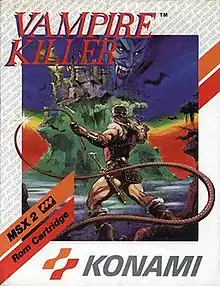Vampire Killer
Vampire Killer[lower-alpha 1] is a platform-adventure video game released by Konami for the MSX2 computer on October 30, 1986. It is a parallel version of the original Castlevania, which debuted a month earlier for the Famicom Disk System under the same Japanese title. However, the MSX2 version was localized first in Europe and thus, was published without the Castlevania branding that the franchise would start using abroad in 1987 when the NES version was released in North America (where neither Vampire Killer nor the MSX2 platform were released).[2]
| Vampire Killer | |
|---|---|
 European box art | |
| Developer(s) | Konami |
| Publisher(s) | Konami |
| Producer(s) | Akihiko Nagata |
| Designer(s) | Akihiko Nagata |
| Composer(s) | Kinuyo Yamashita Satoe Terashima |
| Series | Castlevania |
| Platform(s) | MSX2 |
| Release |
|
| Genre(s) | Platform-adventure |
| Mode(s) | Single-player |
Like in Castlevania, the player controls vampire hunter Simon Belmont, who ventures into Dracula's castle armed with a mystical whip inherited from his father, in order to slay the evil count.
Gameplay
While Vampire Killer shares the same premise, soundtrack, characters and locations as the original Castlevania, the structure of the game and its play mechanics differ significantly from its NES counterpart. Like Castlevania, Vampire Killer consists of 18 stages, with a boss encounter at the end of every third stage. But in contrast to the linear level designs in Castlevania, Vampire Killer features more labyrinth-like stages, requiring the player to not only seek out the exit to the next stage, but also the skeleton key required to unlock it. Due to the hardware limitations of the MSX2, Vampire Killer uses flip screens instead of scrolling. The game can be played with a keyboard or a game controller.
Items and weapons can be obtained not only by breaking through candle stands and certain walls like in the NES version, but also by purchasing them from merchants hidden throughout the castle or by unlocking treasure chests using keys. Simon's default whip can also be replaced with one of four weapons: a chain whip, throwing daggers, an ax, and a cross - the latter two function both like a boomerang and must be retrieved on their return path if the player wishes to preserve them.
There are also four items that Simon can carry with him similar to the sub-weapons in the NES version: a map which shows his current position and the location of the exit (can only be used three times by pressing F2), holy water (used by jumping and then pressing left or right in mid-air), an hourglass (which temporarily paralyzes all enemies by pressing down after jumping) and one of two types of shields. Heart points are used not only as ammunition for the holy water and hourglass (each requiring five hearts per use), but also as currency for merchants.
There are other items that provide more auxiliary effects such as increasing or decreasing the prices of items sold by merchants, temporary invulnerability, increased walking speed and jumping height, and health recovery. After defeating a boss, Simon will start the next stage without any of his previously-accumulated equipment, aside from the number of hearts and the map (if it has not been used up already).
The player starts the game with only three lives and with no way to gain extra lives. There are no continues, unless the game is played the Game Master cartridge on the second slot. Playing with the Game Master will also enable the option to select the stage and the number of lives to start with, as well as the ability to skip screens.
Notes
- Known in Japan as Akumajō Dracula (悪魔城ドラキュラ, Akumajō Dorakyura, lit. Demon Castle Dracula)[1]
References
- Konami (2010-08-04). Castlevania: Harmony of Despair. Konami.
Japanese: 歴代の「悪魔城ドラキュラ」シリーズから選ばれた登場キャラクターを操作して、仲間たちと悪魔城に乗り込み、宿敵ドラキュラ伯爵に立ち向かおう。 English translation: Take control of past protagonists from the Castlevania series to brave the Demon Castle alongside friends and defeat the ancient enemy Count Dracula.
- "Ghosts and Ghoulies" (PDF). Konami Software Club. July 1988. Archived (PDF) from the original on 2019-01-29. Retrieved 2019-01-28.
